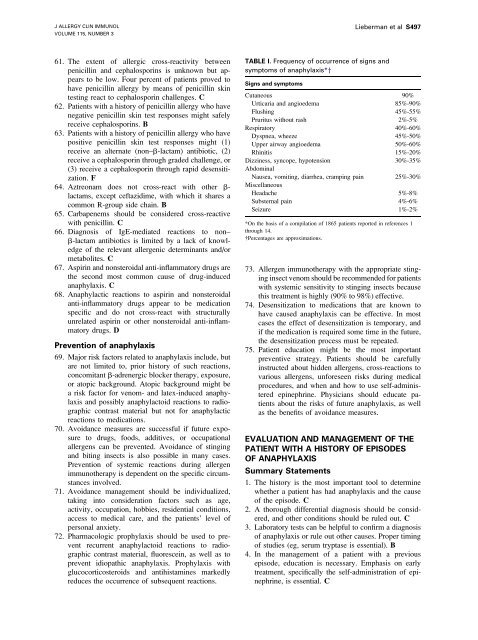Immunotherapy Safety for the Primary Care ... - U.S. Coast Guard
Immunotherapy Safety for the Primary Care ... - U.S. Coast Guard
Immunotherapy Safety for the Primary Care ... - U.S. Coast Guard
You also want an ePaper? Increase the reach of your titles
YUMPU automatically turns print PDFs into web optimized ePapers that Google loves.
J ALLERGY CLIN IMMUNOL<br />
VOLUME 115, NUMBER 3<br />
Lieberman et al S497<br />
61. The extent of allergic cross-reactivity between<br />
penicillin and cephalosporins is unknown but appears<br />
to be low. Four percent of patients proved to<br />
have penicillin allergy by means of penicillin skin<br />
testing react to cephalosporin challenges. C<br />
62. Patients with a history of penicillin allergy who have<br />
negative penicillin skin test responses might safely<br />
receive cephalosporins. B<br />
63. Patients with a history of penicillin allergy who have<br />
positive penicillin skin test responses might (1)<br />
receive an alternate (non–b-lactam) antibiotic, (2)<br />
receive a cephalosporin through graded challenge, or<br />
(3) receive a cephalosporin through rapid desensitization.<br />
F<br />
64. Aztreonam does not cross-react with o<strong>the</strong>r b-<br />
lactams, except ceftazidime, with which it shares a<br />
common R-group side chain. B<br />
65. Carbapenems should be considered cross-reactive<br />
with penicillin. C<br />
66. Diagnosis of IgE-mediated reactions to non–<br />
b-lactam antibiotics is limited by a lack of knowledge<br />
of <strong>the</strong> relevant allergenic determinants and/or<br />
metabolites. C<br />
67. Aspirin and nonsteroidal anti-inflammatory drugs are<br />
<strong>the</strong> second most common cause of drug-induced<br />
anaphylaxis. C<br />
68. Anaphylactic reactions to aspirin and nonsteroidal<br />
anti-inflammatory drugs appear to be medication<br />
specific and do not cross-react with structurally<br />
unrelated aspirin or o<strong>the</strong>r nonsteroidal anti-inflammatory<br />
drugs. D<br />
Prevention of anaphylaxis<br />
69. Major risk factors related to anaphylaxis include, but<br />
are not limited to, prior history of such reactions,<br />
concomitant b-adrenergic blocker <strong>the</strong>rapy, exposure,<br />
or atopic background. Atopic background might be<br />
a risk factor <strong>for</strong> venom- and latex-induced anaphylaxis<br />
and possibly anaphylactoid reactions to radiographic<br />
contrast material but not <strong>for</strong> anaphylactic<br />
reactions to medications.<br />
70. Avoidance measures are successful if future exposure<br />
to drugs, foods, additives, or occupational<br />
allergens can be prevented. Avoidance of stinging<br />
and biting insects is also possible in many cases.<br />
Prevention of systemic reactions during allergen<br />
immuno<strong>the</strong>rapy is dependent on <strong>the</strong> specific circumstances<br />
involved.<br />
71. Avoidance management should be individualized,<br />
taking into consideration factors such as age,<br />
activity, occupation, hobbies, residential conditions,<br />
access to medical care, and <strong>the</strong> patients’ level of<br />
personal anxiety.<br />
72. Pharmacologic prophylaxis should be used to prevent<br />
recurrent anaphylactoid reactions to radiographic<br />
contrast material, fluorescein, as well as to<br />
prevent idiopathic anaphylaxis. Prophylaxis with<br />
glucocorticosteroids and antihistamines markedly<br />
reduces <strong>the</strong> occurrence of subsequent reactions.<br />
TABLE I. Frequency of occurrence of signs and<br />
symptoms of anaphylaxis*y<br />
Signs and symptoms<br />
Cutaneous 90%<br />
Urticaria and angioedema 85%-90%<br />
Flushing 45%-55%<br />
Pruritus without rash 2%-5%<br />
Respiratory 40%-60%<br />
Dyspnea, wheeze 45%-50%<br />
Upper airway angioedema 50%-60%<br />
Rhinitis 15%-20%<br />
Dizziness, syncope, hypotension 30%-35%<br />
Abdominal<br />
Nausea, vomiting, diarrhea, cramping pain 25%-30%<br />
Miscellaneous<br />
Headache 5%-8%<br />
Substernal pain 4%-6%<br />
Seizure 1%-2%<br />
*On <strong>the</strong> basis of a compilation of 1865 patients reported in references 1<br />
through 14.<br />
Percentages are approximations.<br />
73. Allergen immuno<strong>the</strong>rapy with <strong>the</strong> appropriate stinging<br />
insect venom should be recommended <strong>for</strong> patients<br />
with systemic sensitivity to stinging insects because<br />
this treatment is highly (90% to 98%) effective.<br />
74. Desensitization to medications that are known to<br />
have caused anaphylaxis can be effective. In most<br />
cases <strong>the</strong> effect of desensitization is temporary, and<br />
if <strong>the</strong> medication is required some time in <strong>the</strong> future,<br />
<strong>the</strong> desensitization process must be repeated.<br />
75. Patient education might be <strong>the</strong> most important<br />
preventive strategy. Patients should be carefully<br />
instructed about hidden allergens, cross-reactions to<br />
various allergens, un<strong>for</strong>eseen risks during medical<br />
procedures, and when and how to use self-administered<br />
epinephrine. Physicians should educate patients<br />
about <strong>the</strong> risks of future anaphylaxis, as well<br />
as <strong>the</strong> benefits of avoidance measures.<br />
EVALUATION AND MANAGEMENT OF THE<br />
PATIENT WITH A HISTORY OF EPISODES<br />
OF ANAPHYLAXIS<br />
Summary Statements<br />
1. The history is <strong>the</strong> most important tool to determine<br />
whe<strong>the</strong>r a patient has had anaphylaxis and <strong>the</strong> cause<br />
of <strong>the</strong> episode. C<br />
2. A thorough differential diagnosis should be considered,<br />
and o<strong>the</strong>r conditions should be ruled out. C<br />
3. Laboratory tests can be helpful to confirm a diagnosis<br />
of anaphylaxis or rule out o<strong>the</strong>r causes. Proper timing<br />
of studies (eg, serum tryptase is essential). B<br />
4. In <strong>the</strong> management of a patient with a previous<br />
episode, education is necessary. Emphasis on early<br />
treatment, specifically <strong>the</strong> self-administration of epinephrine,<br />
is essential. C
















